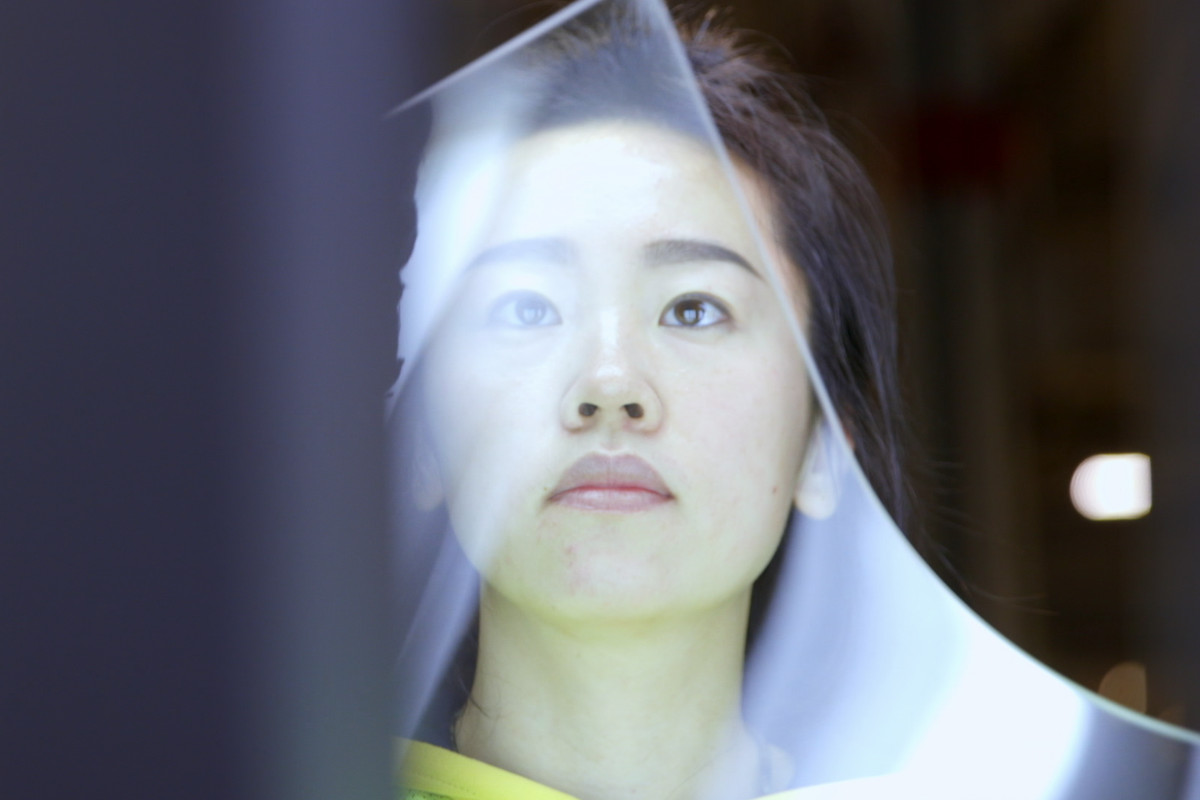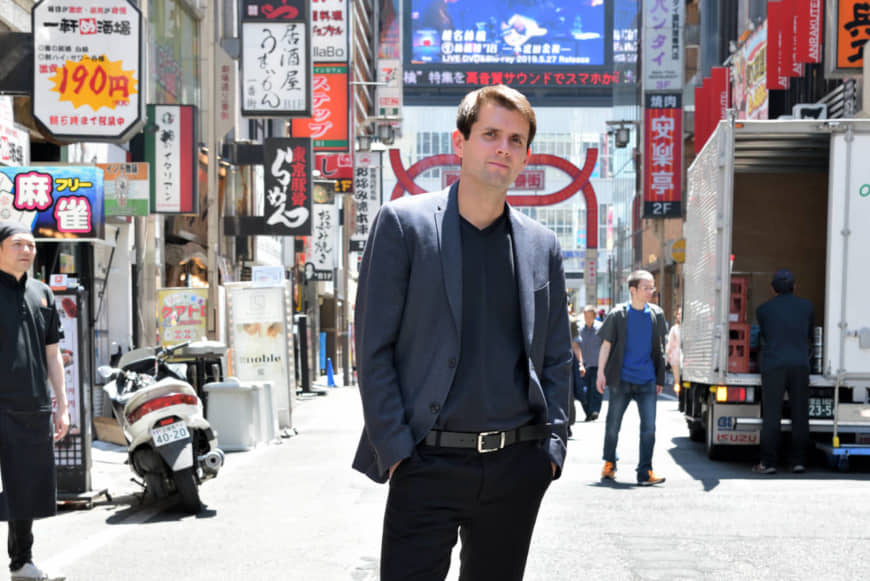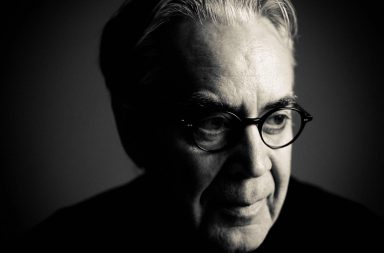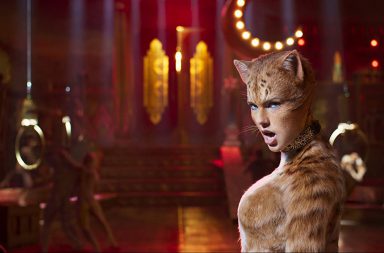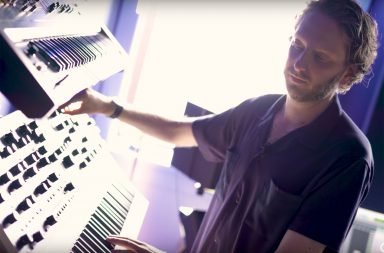Chad Cannon has played a huge role in the making of more than one film we bet you love. An orchestrator for Howard Shore (The Hobbit: The Desolation of Smaug and The Hobbit: The Battle of the Five Armies), Alexandre Desplat (The Secret Life of Pets 1 & 2, Godzilla) and Tyler Bates (Guardians of the Galaxy Vol. 2, The Spy Who Dumped Me), Cannon also excels in composing, his spearhead being documentaries. Some of us may remember his work for the beautiful 2016 documentary Paper Lanterns, the story of a Hiroshima survivor and his search for the truth after revealing that twelve American prisoners were shot while bombs flew over Hiroshima.
Cannon has a long-standing relationship of love and admiration for Asian culture and music, from being a regular collaborator of Japanese music sensei Joe Hisaishi—whose work for Takeshi Kitano’s films and, more importantly, Hayao Miyazaki’s films, has been celebrated by critics and fans all over the world for decades now—to discovering young Asian composers thanks to the Asia/America New Music Institute which he created. His latest work for film is the Netflix documentary American Factory, directed by veteran documentarists Julia Reichert and Steven Bognar, and produced by two newcomers in the filmmaking industry, Michelle and Barack Obama, as the first film of their production company Higher Ground. Chad Cannon delivers a highly inspired score to tell the story of the former General Motors plant in Dayton, Ohio, bought in 2015 by Fuyao, a glass manufacturing company, and the people, American and Chinese, who work there. He told Score It Magazine all about it, and more.
Score It Magazine: American Factory directors Julia Reichert and Steven Bognar did a film ten years ago about the closing of this General Motors factory in Dayton called The Last Truck and it was scored by David Shire. American Factory is sort of a sequel to The Last Truck, but how did you become involved with this film?
Chad Cannon: I had done the Sundance Composers Lab in 2016 and back then, it was divided between fiction films and documentary films, and I was in the documentary section. Since then, they’ve combined it, so it’s just one composers lab, but anyway, someone who helps run that lab knew that I had done a lot of music work in Asia, in both Japan and China, so he referred me to Julia and Steve as someone who might be a good fit for this story about America and China coming together through this factory.
The score for American Factory contains a significant presence of woodwinds, which you used to create melodies that reminded me of John Williams.
He’s the master of all woodwinds.
We can also find the predominance of quiet piano melodies and marching drums as a reminder of the famous battles in the labor history of the USA. All of this mixed together gives a quirky and inspired score. What were your inspirations and did you get many directions from the directors?
Julia was very specific early on that she wanted a woodwind-heavy score. She got that idea because she had recently attended a concert where they performed Mozart’s “Gran Partita” [Ed: the Serenade No. 10], which is a woodwind serenade with a couple of French horns and also a double bass. I think she really loved the sound of that ensemble and thought that this would work well against all the factory noise in the film. And I think she was right, it ended up being a nice contrast from… You know, there’s a ton of machine noise, people are sort of shouting when they’re being interviewed because it’s so loud, and then, underneath that, you have these woodwinds that kind of fill some of this audio spectrum. And, of course, when they mixed the sound at Skywalker, I’m sure they had a lot of work to do all fit together, because there was just white noise in almost all of the audio because it’s so loud.
But yeah, her instructions were to use a lot of woodwinds. I’m a string player, I’ve played violin since I was 4, and she specifically said, “I don’t want any violins on this,” so I left out the violins, I left out myself (laughs) and focused on this woodwind ensemble.
About the percussions you mentioned, it actually was not marching band drums. I brought in a percussionist and we used a very big variety of drums: we had some Korean drums, we had a couple of tablas, these Indian hand drums, which I love—they’re so vocal and there’s so much character there—and also just a lot of other standard percussions like snare drums… I think the snare drum is probably what’s triggering the marching band in your mind, because there are moments where it feels very militaristic, when you have these confrontations between the Union and the management…
There’s definitely, in those scenes, an echo to the big stories of American workers like The Grapes of Wrath or Norma Rae. There’s even a small reference to the latter, when one of the guys from the Union says that “sometimes, you have to be Sally Field.”
Yes. And Julie and Steve have very much… I mean, that’s their world, documenting workers topics for a long, long time. I think this film was surprising in that it’s not really… I mean, it is pro-workers in the sense that we meet a lot of workers and we get to know them, which is first of all unusual, because most films would sort of gloss over the individual workers stories, but they also have the incredible access to the CEO and the upper-level management of the company, so you really do get a very balanced perspective on what’s happening in this great global story.
The balance you’re talking about also serves the film in changing genres. American Factory is, in a way, the great American tragedy of our times, and like all great tragedies, it is helped by the balance between drama and humour, which is one of the significant aspects of the music as well.
Yeah, and I think part of the challenge with this film was to dramatize and emotionalize and turning some scenes into comedy without stepping the lines of documentary scoring.
Complexity is one of the film’s big topics: the complexity of human relationships, of work-related relationships, of two countries that don’t really know how much they have in common… And the way the directors show it is complex in itself. How big was the challenge of giving your own voice to a film that not only has this whole diverse range of points of view, but in which anybody can change his mind at one point?
When it’s something so global and so complex, it is hard, I think, to get the individuality. One of the challenges for me in this score was that there are so many characters we meet, and what’s pretty distinctive of Julia and Steve’s work is that they show a lot of people. It’s not like it’s the story of one person the whole time, so you get a broad lens into this story, and it’s a challenge from both the storyteller’s perspective and the composer’s perspective, because I can’t really associate so much musical themes with one individual, it’s a little harder. There are some characters in the film that really inspired me, such as this character, Wong, who becomes friends with Rob, the American worker. They go shoot guns together (laughs)… At one point, Rob says, “I have his back, just like I have my brother’s back,” like he’s very friendly and loving to Wong. And Wong actually stayed at my house. He came to Sundance when [American Factory] premiered there and my parents live in Salt Lake City, so he came and stayed one night with my family and that was very special. But he was someone who really inspired me because he was really looking to bridge these two cultures through a friendship and through trying to understand the other side, when other people in the film don’t try very hard. So, musically, I tried to reflect that friendship between Wong and Rob through duets, so there’s a clarinet duet when they’re shooting guns—I mean, it’s a duet plus a bass clarinet so it’s like a trio, but the real melodic stuff is happening in the duet—and some of the quiet piano stuff you mentioned earlier is also a duet, where you just have a background of (he plays), and there’s (he hums) this melody that arrives on top of the piano texture, and that’s always in duets. And that happens again at the very end of the film, when you have Chinese workers leaving the factory and American workers leaving the factory, and you get this big duet. It’s me trying to say, “These are two countries that should be harmonizing, and I hope that we can continue to harmonize and not conflict so much.” That’s the message that I’m hoping to contribute to, although it is a complex story, like you said, and it’s not super-triumphant, it’s not super-optimistic, but it’s trying to push you in a positive direction.
The friendship between Wong and Rob was all the more touching since it is not something you would expect… I mean, you don’t know much about Rob except that he is a blue-collar, gun-loving American from Ohio, but you can picture him as a Republican, if you add the fact that Donald Trump won Ohio in 2016. So, it is a pretty unexpected friendship…
One of the things that I think are misunderstood about America is that it is so diverse… Even within a single city you can have half the city being full of immigrants and the other half being completely white. And even within those neighborhoods, there is so much diversity. But what Rob, to me, represents, is that he can sure have a bad situation with his work, but he’s such a nice guy. Even after he gets fired, he said, “I learned a lot from the Chinese, I would do it all over again if I had to…” He’s very inspiring. But you’re right, it is a surprise to have friendships like these that emerge.
You have a long history with Asia and the choice of you scoring American Factory seems natural, since you started a few years ago the Asia/America New Music Institute. Can you tell me a little bit about this?
Asia/America New Music Institute—the acronym is called AANMI— is an initiative I started in 2013. The stated goal of the organization is to create cultural exchange through contemporary music. So we’ve produced concerts where we bring together composers from usually five or six, sometimes seven or eight different countries, and we’re unifying our musical ideas through a common theme. Next summer, we’ll be going to Japan with seven composers from seven countries, and each composer contributes to a new work that’s inspired by or somehow reflects their cultural upbringing. And then we all come together on the stage and we celebrate what brings us together, which is, basically, that we’re all human, even though we come from different places, and we are coming together through the concerts. We’ve done programs in Thailand, in Vietnam, several in China, Korea, we’ve done two big programs in Japan and we’re going back next summer, and then concerts throughout the US as well. It’s just been a really good place where I have made a lot of good friends from different countries and we’re hopefully making the world a better place through face-to-face engagements.
Besides working as a composer, mainly for documentaries, you also served as an arranger and orchestrator for many big-budget films, under the direction of big composers such as Howard Shore, Joe Hisaishi or Alexandre Desplat. What did you learn from them and how did working with them affect your composing approach and technique?
I should start by saying that my work with Howard Shore, Tyler Bates, Alexandre Desplat, is because of these other orchestrators named Conrad Pope and Tim Williams, whom I had been working underneath, so they were the ones I was interfacing directly with. However, I directly work with composer Joe Hisaishi, as his main arranger and orchestrator, and that relationship has been very, very special and interesting, and I learned so much from him.
How long have you been working with him?
Since 2016, so it’s been about three and a half years now. It’s not like I’m working for him every day, he calls me when he has a project that he needs help on. Most recently, we did this animated feature film called Ni no Kuni, which was a Warner Bros. Japan release based on a video game. Hisaishi is a legend in Japan and has fans around the world. We did our first concert of his Hayao Miyazaki film music in Paris in 2017, and people came from all over Europe to attend, but the number one thing I learned from him is that the orchestra has an unlimited number of colors and there’s so much possibility with an orchestra. He conducts and he does a lot of classical music conducting as well, so he just really knows the orchestra. Anytime I give him my arrangements, he’ll make comments, give me feedbacks, and it’s so cool to know that his ears and his experience are as good as it gets. He’s really the John Williams of Japan, you know, he’s just an incredible musician.
Sometimes, when I’m orchestrating, when you get inside the mind of another composer, you can really tell how carefully they thought about things, and without fail, Hisaishi has always thought about everything. It’s very deliberate, and he’s never lazy about his writing, he’s always just top notch.
And the number two thing I have learned from Hisaishi is this ability to, I don’t know how many of the Miyazaki films you’ve seen, but in every one of his films, once you’ve seen it, anytime you hear that music later you’re always gonna remember exactly the character that it went with. John Williams has the same way of working, he attaches a theme so strongly with the visual and the character that you can never forget it. And that’s a skill that only a few people on Earth have, and he’s one of them.
Working under Conrad and Tim for these other Hollywood composer has been equally amazing for me. Conrad Pope is just unbeatable in his orchestration knowledge and he’s worked with almost every A-list composer in the business, so he has a wealth of knowledge that I have been able to draw from him as I worked with him. Desplat is another one who really thinks through his music when he writes it. It’s already pretty complete when Conrad brings me on when we’re working on Desplat’s music, he’s already done the lion’s share of the writing, but Conrad can take that and just make it… He can take something that would otherwise be sort of normal and standard and push it up a level, where it’s a masterpiece, even if it’s just a silly little 30-second cue. It’s been a very special privilege to work with these really incredible musicians, and I would not have been able to create the score I did for American Factory had I not been exposed to Alexandre’s woodwind writing and Conrad’s use of those woodwinds, and similarly with Hisaishi’s use of minimalism in his music, which has also influenced my music a lot.
Interview prepared, conducted and transcribed by Valentin Maniglia. Edited by Marine Wong Kwok Chuen.
